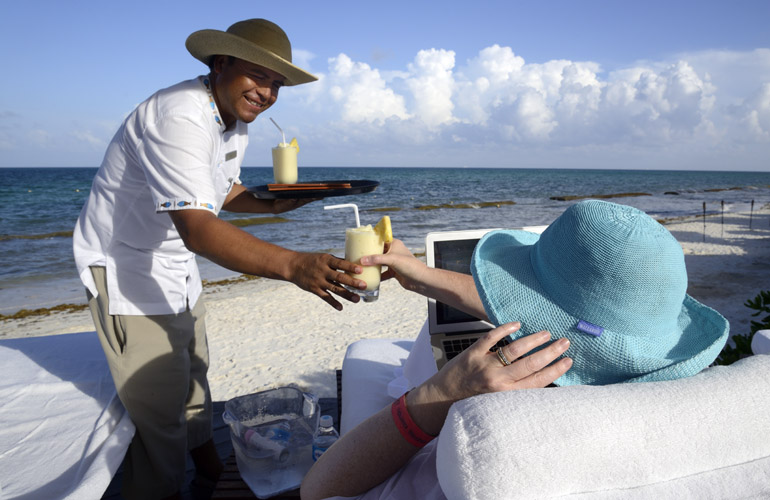How to Keep the Peace on a Family Vacation
 A peaceful trip to Prouts Neck, Maine.
A peaceful trip to Prouts Neck, Maine. There’s the fantasy of a family vacation, and then there’s the reality. There are days—often a dozen times a day—when everybody wants to do something different, go somewhere different, eat someplace different. And then, just when agreement has been reached and everybody’s in a good mood and the weather is cooperating, a child gets an ear infection or a work crisis erupts or your flight is cancelled…and you’re back in meltdown land. I’m no psychiatrist, and Lord knows every family is different, but I’ve now taken my kids (now 11 and 13) to more than two dozen countries and at least that many states, and I know how many of my fellow parents are in desperate need of a harmonious vacation, so I thought I’d be so bold as to offer up a few strategies that have worked for my own family when it comes to keeping the peace—not just with the kids but between the parents:
1. Before you and your spouse start the planning, determine your mutual trip goal.
What is your main shared goal for this vacation? Is it to do nothing on a beach? Explore a destination? Learn to surf? See relatives? Avoid relatives? Sleep? Determine your mutual trip goal so that, whichever parent is making arrangements, you’re both shooting for the same result. Make a mission statement, and check it during the trip.
2. Give each family member ownership of a portion of the trip.
Put each parent and child (who’s old enough) in charge of one day of the vacation, or in charge of one activity each day. Or—at the very least—let each choose one activity during the trip that everybody does together. (If your child is very young, at least let him pick a lunch spot.) The more each family member is invested in the itinerary and has a say in the activities, the less family discord.
3. Set a trip budget, but one that allows for a few splurges.
You don’t want to argue during the trip about how much you’re spending, nor do you want to argue about it after the trip when you get the credit-card bill. When you’re doing a money-bleeding activity such as going to an amusement park, make your child C.F.O. of the trip that day. Seriously, when our 13-year-old is in charge of the budget, it’s remarkable how many strategies he’ll come up with to make us stick to it. (And we feel good because he’s learning a valuable lesson.) Remember that every museum, monument, or aquarium exit is through the gift shop; set not only a budget for gift shops but also a time limit.
4. Choose accommodations that will ensure everyone gets enough sleep.
The last thing you need is a bed configuration that means one family member (parent or child) can’t sleep, putting him/her in a cranky mood that infects everyone. A suite such as the type you find in an extended-stay hotel—where you’ve got a door to the kids’ room that you can close at nap time or bedtime—allows you to have some space, light, and time to yourself, rather than having to tiptoe around in the dark. A house rental provides more space and beds, but be warned that if it comes with no housekeeper or other niceties that a hotel infrastructure provides, it can mean that one parent spends way too much time doing household chores.
5. Choose a soothing activity for shortly after you arrive.
On a trip, your mood tends to dip lowest during the first ten percent of the trip. That’s when you’re dealing with a lot of logistics—possibly including a long drive or flight, jet lag, and sleep deprivation—to get to your destination. Counteract the negative mood that will afflict the family by planning a soothing and reinvigorating activity upon arrival at your destination. A swim for the kids and a massage for the parents can make everyone feel better.
6. Exhaust the kids.
The earlier you can get them to bed at night, the more time you will have alone with your spouse. Tim and I exercise the boys every chance we get during the daytime. If it’s a city trip, that means walking miles each day; if a road trip, it means pit stops at fields where they can play Frisbee; if we’re stuck in a hotel room, it means 100 karate kicks. A simple tennis ball consumes little space in a carry-on and can be a lifesaver.
7. Plan for “couple time.”
In my experience, the best way to ensure you and your partner get a shot at romance — possibly even two or three date nights—is to have easy access to free child care that is your children’s idea of Nirvana. Many resorts and cruise ships offer complimentary supervised kids’ clubs; my children happen to love them. Or consider giving a relative a free trip in exchange for being the babysitter.
8. Carve out “me time” too.
Each parent needs time for himself on vacation, preferably to accomplish something tangible—say, reading an entire novel, or perfecting your golf swing. Having free time and proof of it (e.g., the finished novel) will put you in a better mood around your partner. Again, what I’ve found enables this to happen is built-in child care. On a cruise, for instance, everyone in the family gets “me time.”
9. Pack an outlet splitter.
Let’s face it: When you’re squeezed together like sardines on long car rides and flights, electronics are often the easiest and, for today’s teens, sometimes an essential way to keep the peace. Pack whatever you need to keep everyone’s devices charged in transit; that may include a power inverter for the car and an outlet splitter for the airport gate and hotel rooms.
10. If you must work, do it when it won’t detract from a family activity.
Sometimes you can’t avoid having to work on vacation. Do it while your kids are sleeping or productively occupied in the kids’ club, or while your spouse is in the shower or finishing up that novel. When I’m on deadine I often skip activities that my kids can enjoy alone with Dad (e.g., mini-golf or fishing) in favor of activities that are unique to the destination or that we’ve never done as a family before.
I’d love to hear: What strategies do you have for keeping the peace on a family vacation?









